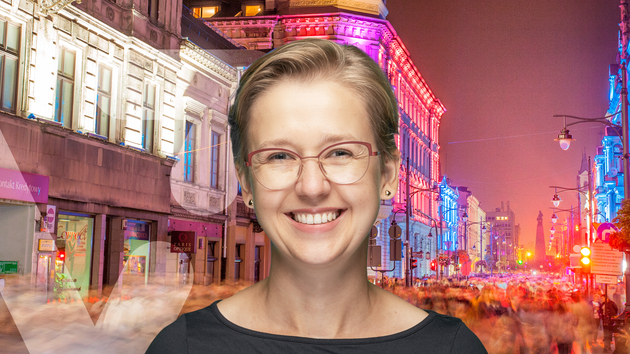Dr Aleksandra Mroczek-Żulicka is interviewed by Jolanta Sławińska-Ryszka from the Communications and PR Centre at the University of Lodz.
A study on different forms of recreation in Lodz
What leading forms of recreation did you define during your interviews with inhabitants of Lodz while working on your doctoral dissertation?
In the course of the research, I selected specific events which inhabitants of Lodz and tourists visiting our city participate in. These had to be events which are held outdoors, in an open space, addressed to both adults and children. I wanted to be able to survey primarily adult participants in the events. An important aspect of the events selection was the creative component, i.e. that which is defined as innovative, original, but also carrying value for the participants: including social, cognitive, cultural value. The study covered events that took place in 2019 in Lodz – most of which were organised during the summer season.
Above all, these were events that explored the history or space of the city in some way. They always involved a component of getting to know the space, becoming familiar with it, deepening one’s knowledge of it. Quite a few events were organised in cooperation with people who are professionally involved in guiding people around Lodz: they obviously had the value of getting familiar with, but also of rediscovering the city. The biggest discovery in this work was the fact that the events that attempted to combine artistic activity with learning about the space and its history in order to make friends and become familiar with it were very popular among the surveyed inhabitants.

So, in your survey of inhabitants did you refer to which offered activities they participated in? Did you study the preferences of the inhabitants as to what events they would like to participate in or what they do to realise themselves on a daily basis on their own initiative?
I studied participants in the selected events. I also studied their preferences: what they like to do in terms of recreation, what forms they choose most often. The study sample was not representative, so we cannot generalise the results. Indeed, the study participants were most likely to choose such activities, which in the recreational divisions were described as cultural, cultural-social activities. Responses related to cultural and leisure activities were mostly strongly marked. They weren't physical or physical recreation activities, so that was quite interesting too. It should be remembered that among the study participants, the majority were women and people with a higher education. It was also indicated in the questionnaire that these types of activities, which I described as creative recreation, should develop further. At the same time, it is worth adding that there was a bit of a problem with this concept, as it generally did not function in the minds of the study participants.
So, do you propose to broaden and deepen the understanding of recreation to include creative recreation, using both the assumptions of humanistic geography and psychopedagogical theories explaining the phenomenon of creativity?
Geography from a humanistic perspective deals with what the relationship between human and space is. The place where we live and function matters, because what matters is the kind of connection we feel with the space and how it affects us. By exploring recreation, we can interpret a space (e.g. an urban space): to what extent the potential of a place, its history, its sensorium and its personal relationship are encouraging for events. This becomes important for recreation organisers. As a result, the rediscovery of space by a participant in this type of an event can influence the building of a bond with the city, a different perception and interpretation of space. So, I was interested in how the relationship with the city and the space can inspire us. And this is where the issues of humanistic geography come into contact with the psychopedagogy of creativity. External conditions, the broadly understood environment, that influence the process constitute one aspect of the study of creativity processes. In my research I aimed at analysing the external conditions, i.e. the urban recreational space organisation in the development of outdoor creative recreation, i.e. events organised in open space with an unconventional theme or form. As an inhabitant of Lodz, I like to look at the city. When walking through the streets I wonder what it encourages me to do, how it inspires me both in my professional and personal life. Is the history of the backstreet, the courtyard, close to me? What can I do next with this story, object?
Did the study participants indicate spaces that were of high importance to them? Can you give some examples of such places, creative places?
This is what I asked the organisers of the outdoor creative recreation about. The survey of the events participants focused on an overall assessment of the elements of the urban recreational space organisation and their own preferences for recreational activities. Lodz's green spaces, both in terms of their number and quality, were rated positively. In turn, among the interviewed organisers, the key question for me was what stimulates, encourages and inspires them in the space of Lodz, especially in the urban recreational space organisation. I was curious what they pay attention to, what their relationship with the city is. Therefore, in addition to interviewing the study participants, I conducted an ethnographic visual survey. I asked them to select and take photographs of their creative places. It is noteworthy that the places they indicated were characterised by a high degree of emotionality, often linked not only to their professional lives, but also to their private lives. As for specific locations, they were not very surprising to me: Piotrkowska Street, Księży Młyn, the courtyards on Piotrkowska Street, the woonerf overlooking the Grand Theatre, the area around the Fabryczna Railway Station or the so-called Unicorn Stable. The justifications were interesting and very inspiring: they were as much about relationships as about seeing change in the city. Fascination of one study participant with the fact that in Lodz (this is one of my favourite quotes from the work) there is still construction in process taking place is something that particularly stuck in my mind.
Primarily urbanised spaces appear here. Are there no examples drawn from nature?
Helenów Park with a restaurant in the park that is no longer open was the only example.

Urban space organisation – a very important issue
What importance would you assign to the urban recreational space organisation in projects that are based on creative recreation? The identity and reference of the organiser to a space that is close to them because it is the immediate vicinity, not necessarily going into green spaces?
The story behind the chosen space constituting its very important backdrop was the most important thing from the perspective of the organisers of the studied events. These were not random locations. The events were organised in specific, well thought over locations because specific stories were associated with them that the organisers wanted to tell, or they wanted to build the story, the plot of the event on it. Summing up, the notion of a humanistic geography was of key importance here.
Let's move to the question of good advice for organisers. How do you organise space for events? I would like to ask Dr Aleksandra Mroczek-Żulicka for recommendations.
I have prepared two types of recommendations. The first one concerns the organisation of urban recreational space and the second one is related to the support for organisers in this area. In terms of organising the space, these are very mundane matters, namely access to water, toilets and electricity. Urban spaces should be designed taking facilities for outdoor events in mind. Paying increased attention to the cleanliness and safety of spaces and the promotion of less popular green spaces is also suggested. In terms of support for organisers, simplification of formal and legal procedures for the organisation of outdoor events is recommended. It would also be helpful to increase funding for competitions for organising creative endeavours and to construct, in cooperation with organisers, a coherent urban leisure offer based on a diagnosis of needs.

A well-tailored space
It’s time to be specific. Would you be able to create, in cooperation with an architect or a team, a vision, a design for a model space, well-tailored for creative recreation in Lodz based on your research results and conclusions?
Quite a few people indicated Źródliska Park as such a place. This park has facilities in the form of the Tubajka café, which provides the basic infrastructure, i.e. access to electricity, water and toilets. In addition, the history of the park is unique and provides an inspiring backdrop for many events. The green area also encourages active leisure activities. Both participants and organisers also willingly choose urban green spaces. Most of the events organised during the period of the study took place in green spaces and post-industrial spaces. Geyer Gardens were opened in 2019, so, this venue stood out in terms of the range of outdoor creative events on offer. The nature of the post-industrial spaces, together with the prepared, appropriate infrastructure, can provide inspiration for the organisation of unusual events. Thus, based on my research, two spaces could be created, i.e. a model space in a park and a model space in a post-industrial area.
The moment has come for you to indicate your creative place where, while being an organiser, you could realise yourself.
I have to admit that I am very biased because I love Piotrkowska Street and have a personal bond with it – probably because I lived there for many years. The entire history of the city is written on it. Many events are organised there, but in my opinion there are still few of them. Piotrkowska Street should be vibrant with life and creativity at all times.
There are all sorts of events organised there, but are they creative recreation?
They are. However, they are organised rarely, in my opinion too rarely. A variety of events are organised, but I don't think they exhaust the potential and the historical and cultural richness of the street. To me, it seems an underrated gem. Fortunately, there are more and more intriguing and interesting walks organised there. Thanks to an unconventional group of people the lesser-known details of, for example, courtyards are shown while taking a tour of the city.
Creative recreation, issues and application
We have been talking a lot about space, but it's time for a definition of creative recreation. What does this concept bring to the city, what does the research say about it?
Creative recreation is an activity that is done in leisure time. It has two important components: it is original, i.e. it does not replicate certain patterns of organising events in a particular place and time. The second component is value, i.e. ensuring that the events organised are not only interesting, original, but also provide participants with opportunities to develop – develop cognitively, spiritually, socially, culturally. As the study results indicated, people are looking for originality, not only in terms of looking for an interesting offer, but also for self-development opportunities.
It is also becoming increasingly important to be able to participate in outdoor events, to spend time outdoors. The need for contact with other people, i.e. building relationships and integrating communities has been also indicated in the research. In addition, participation in outdoor creative recreation can help people learn about their own city, so the cognitive component of these events becomes very important. The relationship between participants and organisers also turned out to be important. They often become the inspiration for organising further proposals for creative recreation.
And now a question which is a little off the subject. Shopping centres, how do you feel about these types of places? Some call them recreational spaces. Did you explore these kinds of spaces in your work?
I was curious to find out more information about the offer of shopping centres in Lodz. The conclusion was that the ventures organised there are usually not very original. Recurring elements include: a simple playground, animations for children focused on activities such as face painting, further screenings of outdoor cinema. In my opinion, the Manufaktura shopping centre has the greatest potential due to the fact that it is located in a very characteristic location and the historical identity of the building is being used there. Only this venue could stand out in the inventory of events in 2019. I believe that open spaces in the shopping centres did not offer anything that could be classified as creative recreation.
And a final question. What are your future career plans related to?
I am preparing a monograph based on my doctoral dissertation. I would like this book to become known in the community, because personally it has become an excuse for me to gain a deeper understanding of my own city. From a scientific point of view, I think it is valuable to emphasise the importance of the individual's relationship with the space, to analyse the developing leisure activities that at the same time contribute to a positive image of the city, but also to the quality of life of the inhabitants. What might this mean in practice? Perhaps this concept should be translated into the language of local government and we should convince local authorities to use it when developing municipal policies, programmes or designing and commissioning tasks based on creative recreation.
Thank you for the interview and I wish you the best of luck in your future scientific work.
The interview was conducted by Jolanta Sławińska-Ryszka from the Communications and PR Centre at the University of Lodz.
Photos: Dr Aleksandra Mroczek-Żulicka from the Faculty of Geographical Sciences, University of Lodz
Edit: Communications and PR Centre, University of Lodz


